Term 1 Chapter 2 | 5th Science - Matter and Materials | 5th Science : Term 1 Unit 2 : Matter and Materials
Chapter: 5th Science : Term 1 Unit 2 : Matter and Materials
Matter and Materials
UNIT 2
Matter and Materials

Learning Objectives
After completing this
lesson students will be able to:
• know about matter and
materials.
• understand the process
of manufacturing fabrics.
• know the varieties of
grains and the food products.
• understand why do things
float or sink.
Introduction
Our needs have increased in the modern
days and we use number of things in our daily life. We get some of them from
the nature and some other things are manufactured artificially. The things you
use like pen, pencil, ink, eraser, note book, ball and the food you eat, all
have different nature and characteristics. They are obtained by transforming
the natural and artificial substances. In this lesson we will study about
different things used in our life and how they are obtained.
I. States of Matter
Matter is anything that has mass and
occupies space. Matter can exist in three physical states: solid, liquid and
gas. It is made up of molecules and the molecules are made up of atoms.
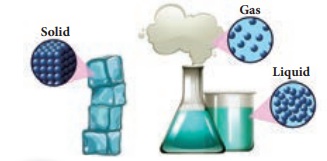
• Solid
In solids molecules are very closely arranged.
Solids are incompressible. They have definite shape, size and volume.
• Liquids
In liquids molecules are loosely packed.
Hence, liquids are negligibly compressible. They have definite volume, but no
definite shape and size.
• Gas
In gases, molecules are very loosely
packed. Hence, gases are highly compressible.
Activity 1
Look at your surrounding. Give
some examples for solids, liquids and gases. Solids
Liquids gases
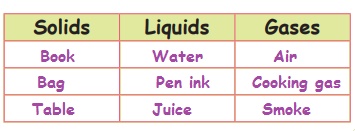
II. Materials
A
material is a mixture of substances that constitute an object. They can be pure
or impure, natural or man made. Materials are needed to get the things needed
for our daily life. We need food, dress and many other goods for our daily
living. Natural and man made materials are transformed to produce these things.
III.
Fibres
Fibre is a thin thread of natural or
artificial substances. It is used to make cloths with the help of powerlooms or
weaving machines. The fibres we get from plants and animals are called natural
fibres. Cotton, jute, coir, flax, hemp are examples for plant fibres. Wool and
silk are examples for animal fibres. Fibres made by humans by chemical
synthesis are called synthetic fibres or artificial fibres. Rayon, nylon,
acrylic and dacron are examples for artificial fibres. These fibres are
obtained from petroleum by complex chemical processes.
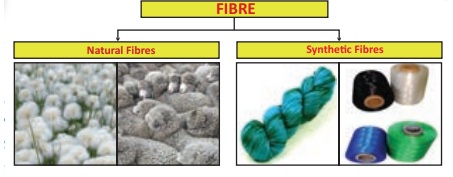
1. Natural Fibres
• Cotton
A
cotton plant is a bushy plant of 5 to 6 feet high. Cotton grows well in black
soil and alluvial soil. The cotton plant bears a large number of small green
pods called cotton balls. These balls contain seeds covered with white fibres.
When the cotton balls mature, they burst exposing the white fibre of cotton.
Cotton is usually hand picked from the plants.
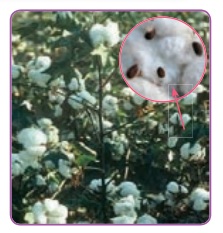
Ginning
There
are two processes to make cotton yarn from cotton fibre. The raw fibres are
separated from the seeds by a process known as Ginning. The fibrous material
left after separating cotton seeds is called lint. The lint is then tied and
pressed into balls. The final proportions of short fibres and other impurities
are removed by the process of combing.
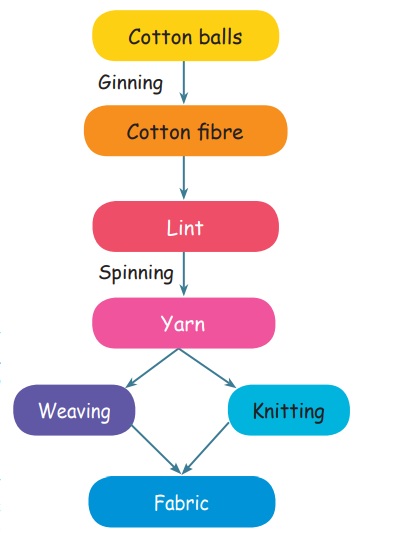
Spinning
The process of making yarn from lint (fibre)
is called spinning. Spinning is done on a large scale with the help of spinning
machines.
Yarn to fabrics
Weaving and knitting are the two most important
processes used for making fabric from the yarn. The process of making two sets
of yarns together to make fabric is called weaving. It is done by weavers on a
machine called loom. The loom are either hand – operated (hand looms) or power
- operated. During knitting a single yarn is used to make a piece of fabric. It
is done by hand and also on machine.
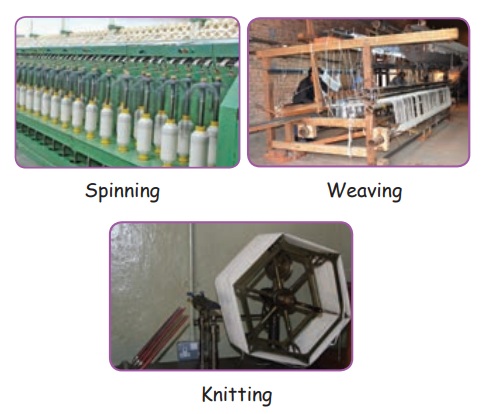
Uses
of cotton
• It is used to manufacture cotton
textiles and garments.
• It is used as fillers in pillows and
mattresses.
• It used for making surgical bandages.
• It is used for making dhotis, sarees,
bedsheets, table cloth and so on.
• Jute
Jute fibre is obtained from the stem of
the jute plant. Jute plant has long, soft and shiny fibres. It is also referred
to as the golden fibre due to its colour and
cost effectiveness. Jute fibres are separated from the process of retting jute
by hand and then they are dried. These are converted into yarns in the same
manner as in the case of cotton.
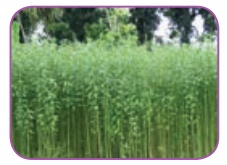
Uses
of Jute
• It is used for making bags, carpets,
curtains and ropes.
• It is used for making clothes for
wrapping bales of raw cotton and to make socks for storing grains.
• It is used for making wall hangings
for decoration.
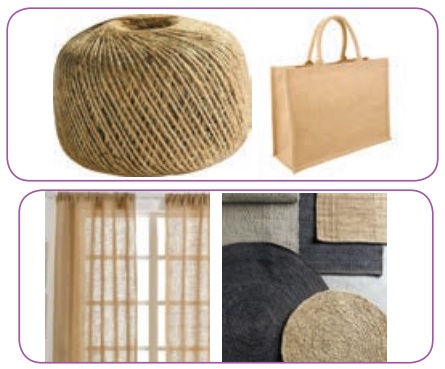
• Coir
Coir
fibre is obtained from the outer covering of coconut. It is used to make floor
mats, door mats, brushes and mattresses.
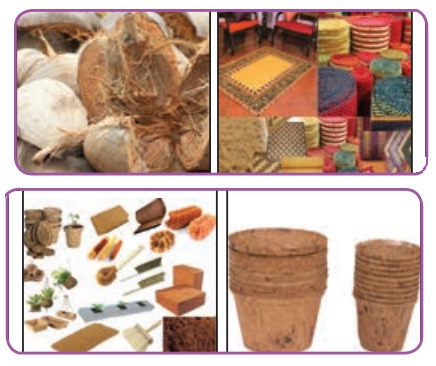
2. Synthetic Fibres (or) Manmade Fibres
These fibres are made by human beings with the
help of chemical process. Hence, they are called synthetic fibres or manmade
fibres. These fibres are obtained from coal, petroleum and natural gas.
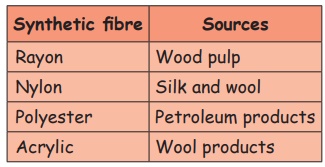
Activity 2
Classify the following
natural fibres. Polyster, Jute, Silk, Nylon, Cotton, Wool, Acrylic, Rayon.

Uses
of synthetic fibres
• Rayon is used to make rope, cloth,
cap, tyre cords and carpets.
• Nylon is used to make fishing nets,
ropes, parachutes, fabrics and bristles for brushes.
• Polyester is used to make fabric for
suits and shirts, hoses, conveyer belts, films, PET bottles and wires.
• Acrylic is used to make sweaters,
shawls and blankets.
Do you know?
The world‛s most valuable
fibre is
obtained from a small wild animal called Vicuna. It
belongs to a camel family.
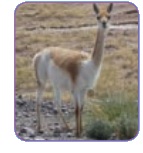
IV. Grains
Grain
s a small, hard, dry seed. Each grain is protected by a husk and the husk
encloses the seed. Two main types of commercial grain crops are cereals and
legumes. Wheat, maize, rice, beans, peas, barley and millets are some of the
whole grains.
• Wheat
This
is the most important crop cultivated in the world. Whole wheat is important
because it is rich in fibre, vitamins and minerals. Wheat products are: Breads,
Cakes, Pasta, Wheat germ and Cracked wheat.
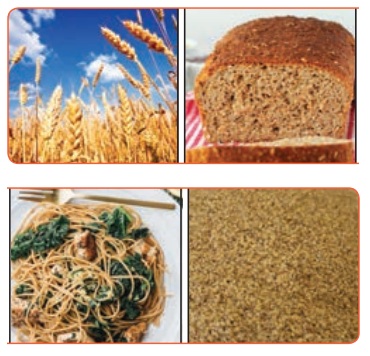
• Maize
In
many tropical and sub tropical countries (Mexico and America), maize is the
main food that people eat. It is also known as corn. Maize is also made into
oil for cooking. Yellow or coloured corn may promote eye health. It is also
rich source of many vitamins and minerals. Corn syrup is used as a sweetener
instead of sugar in many products. Maize products are: Sweet corn, Breakfast
cereal, Tortilla chips, Taco and Maize oil.
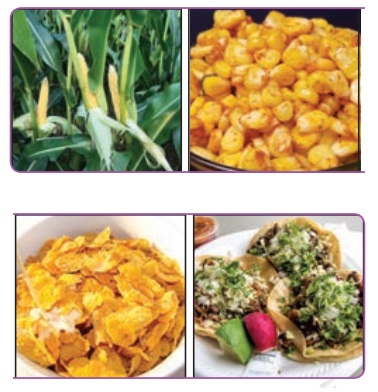
• Rice
Rice
is a type of grass. It is produced worldwide after sugarcane and maize. Large
parts of the world‛s human population especially people in Asia have this as
their main food. Ninety percent of the world‛s rice production is in Asia.
White rice contains few essential nutrients. Brown rice is a whole grain that
contains the fibrous bran. Brown rice is usually considered much healthier than
white rice. Rice idly, Idiappam and Rice aval (Flattened rice) are the food
items made from rice.
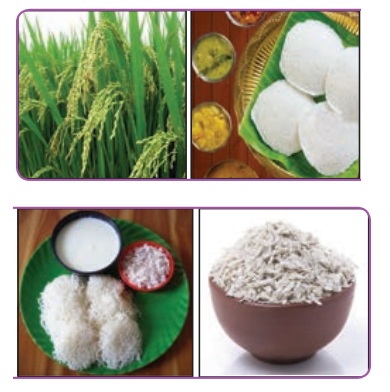
• Millets
Millets
are a group of small seeded grasses. They are widely grown around the world as
cereal crops for fodder and human food. It helps in weight loss. It is rich in
fibre. Some of the millet products are Sorghum, Fox tail millet, Finger millet,
Pearl millet, Barnyard millet, Kodo millet and Little Millet.
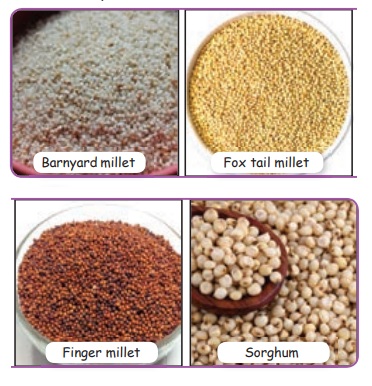
V. Household Goods
These
are the products that we use in our house. The goods that are found in a house
permanently are called household goods. Household goods are: Furniture,
Kitchenware, Cloths, Towels, Beddings, Boots and Electronic goods.
Household goods used in
the olden days

Household goods used in
the modern days

VI. Sinking and Floating
You
could have seen that some objects float in water while others sink. Whether an
object floats or sinks is determined by its density. When an object is immersed
in a liquid, the liquid exerts an upward force on the object. It is known as
upthrust. What happens if you put a coin and an empty water bottle in water?
The weight of the coin is greater than the upthrust and so the coin sinks. But
it is less on the empty water bottle and so it floats.
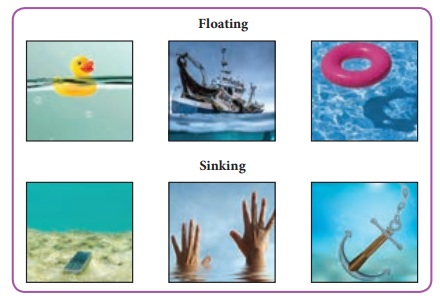
Activity 3
Take water in a bucket and
drop the following items in the water.
Apple, Scissors, Silver
fork, Marbles, Plastic ball.
Fill the table with your
observation.
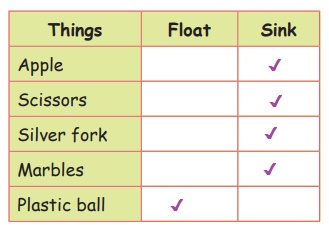
Do you know?
A fish can control the upthurst
on its body. So it can float and go beneath the surface of the water.
VII. Solubility of Solids in Water
Some
substances completely dissolve in water. We say that these substances are
soluble in water. Other substances do not dissolve in water even after we stir
for long time. These substances are insoluble in water.
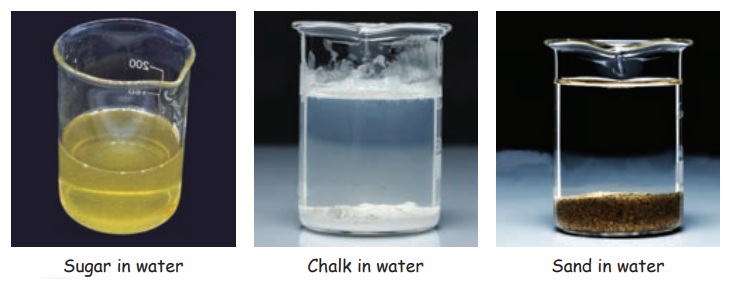
Activity 4
Collect some samples of
solid substances such as salt, sugar, chalk powder, sand and saw dust.
Take five beakers filled with water and add a
small amount of sugar to the first beaker, salt to the second and similarly,
add small amounts of other substances in other beakers. Stir the content with a
glass rod. Wait for few minutes. What happens to the substances added? Note
your observation.

VIII. Mixing
Certain liquids are heavier (dense) than
other liquids. When you attempt to mix liquids which have different densities
they separate when you stop mixing them. The heavier liquid deposits at the
bottom and the lighter liquid floats on the top.
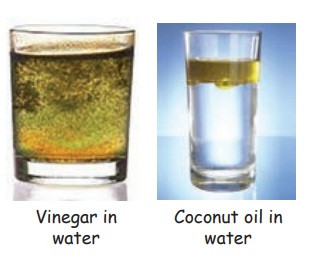
Activity 5
Collect samples of coconut
oil, kerosene, mustard oil, lemon juice and vinegar. Take five test tubes, fill
them up to half with water. Add a spoon full of one liquid to this and stir it
well. Keep it in a test tube stand and wait for few minutes. Observe whether the
liquid mixes with water. Repeat the experiment with other liquids and tabulate
your observation.
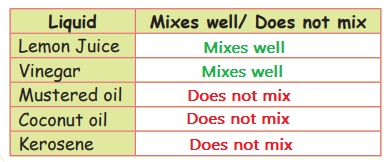
Do you know?
• Substances with similar
chemical properties will mix.
• Substances with
different chemical properties will not mix.
Related Topics